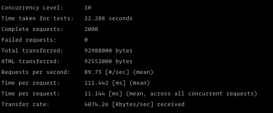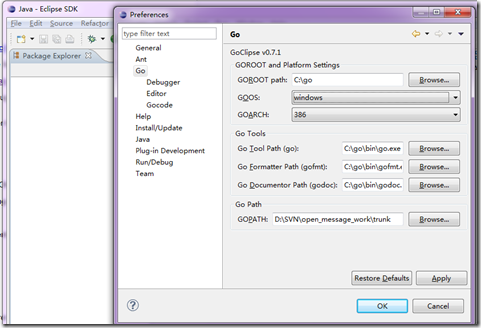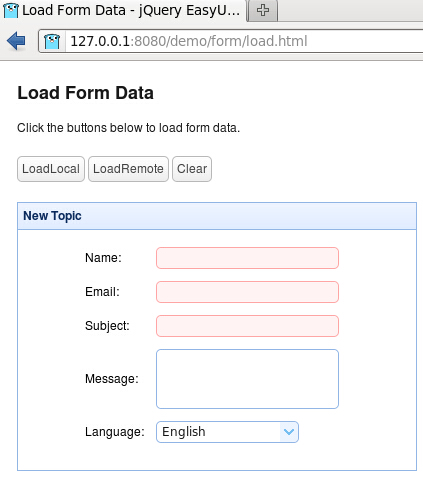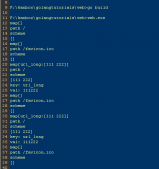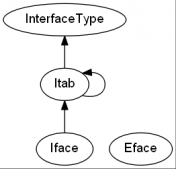1 bytes.Buffer定义
bytes.Buffer提供可扩容的字节缓冲区,实质是对切片的封装;结构中包含一个64字节的小切片,避免小内存分配:
|
1
2
3
4
5
6
7
8
|
// A Buffer is a variable-sized buffer of bytes with Read and Write methods.// The zero value for Buffer is an empty buffer ready to use.type Buffer struct { buf []byte // contents are the bytes buf[off : len(buf)] off int // read at &buf[off], write at &buf[len(buf)]--->指示读指针 bootstrap [64]byte // memory to hold first slice; helps small buffers avoid allocation. lastRead readOp // last read operation, so that Unread* can work correctly.} |
2 初始化bytes.Buffer的方法
1) var buf bytes.Buffer ->定义一个空的字节缓冲区
2) func NewBuffer(buf []byte) *Buffer { return &Buffer{buf: buf} } -->将字节切片初始化为缓冲区
3) func NewBufferString(s string) *Buffer {return &Buffer{buf: []byte(s)}} -->将字符串初始化为缓冲区
3 提供的主要API函数
1)写字节流数据到缓冲区
|
1
2
3
4
5
6
7
8
|
// Write appends the contents of p to the buffer, growing the buffer as// needed. The return value n is the length of p; err is always nil. If the// buffer becomes too large, Write will panic with ErrTooLarge.func (b *Buffer) Write(p []byte) (n int, err error) { b.lastRead = opInvalid m := b.grow(len(p)) return copy(b.buf[m:], p), nil} |
2)写字符串到缓冲区
|
1
2
3
4
5
6
7
8
9
|
// WriteString appends the contents of s to the buffer, growing the buffer as// needed. The return value n is the length of s; err is always nil. If the// buffer becomes too large, WriteString will panic with ErrTooLarge.func (b *Buffer) WriteString(s string) (n int, err error) { b.lastRead = opInvalid //返回写入的index m := b.grow(len(s)) return copy(b.buf[m:], s), nil} |
3)从缓冲区中读取数据
|
1
2
3
4
5
6
7
8
9
10
11
12
13
14
15
16
17
18
19
20
21
|
// Read reads the next len(p) bytes from the buffer or until the buffer// is drained. The return value n is the number of bytes read. If the// buffer has no data to return, err is io.EOF (unless len(p) is zero);// otherwise it is nil.func (b *Buffer) Read(p []byte) (n int, err error) { b.lastRead = opInvalid if b.off >= len(b.buf) { // Buffer is empty, reset to recover space. b.Truncate(0) if len(p) == 0 { return } return 0, io.EOF } n = copy(p, b.buf[b.off:]) b.off += n if n > 0 { b.lastRead = opRead } return} |
4)从缓冲区中读取字符串,直到分隔符delim 位置
|
1
2
3
4
5
6
7
8
9
10
|
// ReadString reads until the first occurrence of delim in the input,// returning a string containing the data up to and including the delimiter.// If ReadString encounters an error before finding a delimiter,// it returns the data read before the error and the error itself (often io.EOF).// ReadString returns err != nil if and only if the returned data does not end// in delim.func (b *Buffer) ReadString(delim byte) (line string, err error) { slice, err := b.readSlice(delim) return string(slice), err} |
5)将未被读取的字节数据返回
|
1
2
3
4
5
6
|
// Bytes returns a slice of length b.Len() holding the unread portion of the buffer.// The slice is valid for use only until the next buffer modification (that is,// only until the next call to a method like Read, Write, Reset, or Truncate).// The slice aliases the buffer content at least until the next buffer modification,// so immediate changes to the slice will affect the result of future reads.func (b *Buffer) Bytes() []byte { return b.buf[b.off:] } |
6)将未被读取的字节数据以字符串形式返回
|
1
2
3
4
5
6
7
8
9
|
// String returns the contents of the unread portion of the buffer// as a string. If the Buffer is a nil pointer, it returns "<nil>".func (b *Buffer) String() string { if b == nil { // Special case, useful in debugging. return "<nil>" } return string(b.buf[b.off:])} |
7)返回缓冲区当前容量
|
1
2
3
|
// Cap returns the capacity of the buffer's underlying byte slice, that is, the// total space allocated for the buffer's data.func (b *Buffer) Cap() int { return cap(b.buf) } |
8)返回未被读取的字节数据大小
|
1
2
3
|
// Len returns the number of bytes of the unread portion of the buffer;// b.Len() == len(b.Bytes()).func (b *Buffer) Len() int { return len(b.buf) - b.off } |
4 bytes.Buffer自动扩容机制
当向缓冲区写入数据时,首先会检查当前容量是否满足需求,如果不满足分三种情况处理:
1)当前内置缓冲区切片buf为空,且写入数据量小于bootstrap的大小(64字节),则bootstrap作为buf
2)当前未读数据长度+新写入数据长度小于等于缓冲区容量的1/2,则挪动数据(将未读的数据放到已读数据位置)
3)以上条件不满足,只能重新分配切片,容量设定为2*cap(b.buf) + n,即两倍原来的缓冲区容量+写入数据量大小
|
1
2
3
4
5
6
7
8
9
10
11
12
13
14
15
16
17
18
19
20
21
22
23
24
25
26
27
28
29
30
31
32
33
34
35
|
// grow grows the buffer to guarantee space for n more bytes.// It returns the index where bytes should be written.// If the buffer can't grow it will panic with ErrTooLarge.func (b *Buffer) grow(n int) int { m := b.Len() // If buffer is empty, reset to recover space. if m == 0 && b.off != 0 { b.Truncate(0) } //如果需要的容量大于现在的容量---> if len(b.buf)+n > cap(b.buf) { var buf []byte //现有的预备64byte可以满足 if b.buf == nil && n <= len(b.bootstrap) { buf = b.bootstrap[0:] //实际需要的小于本身切片容量 } else if m+n <= cap(b.buf)/2 { // We can slide things down instead of allocating a new // slice. We only need m+n <= cap(b.buf) to slide, but // we instead let capacity get twice as large so we // don't spend all our time copying. copy(b.buf[:], b.buf[b.off:]) buf = b.buf[:m] } else { // not enough space anywhere //不够,那就分配2倍加n的容量 buf = makeSlice(2*cap(b.buf) + n) copy(buf, b.buf[b.off:]) } b.buf = buf b.off = 0 } b.buf = b.buf[0 : b.off+m+n] return b.off + m} |
5 bytes.Buffer的局限
bytes.Buffer提供了对切片的初步封装,但也没做太多的事;对于已读的数据无法操作。
补充:Golang bytes.Buffer 用法精述
1.简介
bytes.Buffer 是 Golang 标准库中的缓冲区,具有读写方法和可变大小的字节存储功能。缓冲区的零值是一个待使用的空缓冲区。
定义如下:
|
1
2
3
4
5
|
type Buffer struct { buf []byte // contents are the bytes buf[off : len(buf)] off int // read at &buf[off], write at &buf[len(buf)] lastRead readOp // last read operation, so that Unread* can work correctly.} |
注意要点:
(1)从 bytes.Buffer 读取数据后,被成功读取的数据仍保留在原缓冲区,只是无法被使用,因为缓冲区的可见数据从偏移 off 开始,即buf[off : len(buf)]。
2.常用方法
(1)声明一个 Buffer
|
1
2
3
4
|
var b bytes.Buffer //直接定义一个Buffer变量,不用初始化,可以直接使用b := new(bytes.Buffer) //使用New返回Buffer变量b := bytes.NewBuffer(s []byte) //从一个[]byte切片,构造一个Bufferb := bytes.NewBufferString(s string) //从一个string变量,构造一个Buffer |
(2)往 Buffer 中写入数据
|
1
2
3
4
5
|
b.Write(d []byte) (n int, err error) //将切片d写入Buffer尾部b.WriteString(s string) (n int, err error) //将字符串s写入Buffer尾部b.WriteByte(c byte) error //将字符c写入Buffer尾部b.WriteRune(r rune) (n int, err error) //将一个rune类型的数据放到缓冲区的尾部b.ReadFrom(r io.Reader) (n int64, err error) //从实现了io.Reader接口的可读取对象写入Buffer尾部 |
(3)从 Buffer 中读取数据
|
1
2
3
4
5
6
7
8
9
10
11
12
13
14
|
//读取 n 个字节数据并返回,如果 buffer 不足 n 字节,则读取全部b.Next(n int) []byte//一次读取 len(p) 个 byte 到 p 中,每次读取新的内容将覆盖p中原来的内容。成功返回实际读取的字节数,off 向后偏移 n,buffer 没有数据返回错误 io.EOFb.Read(p []byte) (n int, err error)//读取第一个byte并返回,off 向后偏移 nb.ReadByte() (byte, error)//读取第一个 UTF8 编码的字符并返回该字符和该字符的字节数,b的第1个rune被拿掉。如果buffer为空,返回错误 io.EOF,如果不是UTF8编码的字符,则消费一个字节,返回 (U+FFFD,1,nil)b.ReadRune() (r rune, size int, err error)//读取缓冲区第一个分隔符前面的内容以及分隔符并返回,缓冲区会清空读取的内容。如果没有发现分隔符,则返回读取的内容并返回错误io.EOFb.ReadBytes(delimiter byte) (line []byte, err error)//读取缓冲区第一个分隔符前面的内容以及分隔符并作为字符串返回,缓冲区会清空读取的内容。如果没有发现分隔符,则返回读取的内容并返回错误 io.EOFb.ReadString(delimiter byte) (line string, err error)//将 Buffer 中的内容输出到实现了 io.Writer 接口的可写入对象中,成功返回写入的字节数,失败返回错误b.WriteTo(w io.Writer) (n int64, err error) |
(4)其它操作
|
1
2
3
4
5
6
7
8
9
|
b.Bytes() []byte //返回字节切片b.Cap() int //返回 buffer 内部字节切片的容量b.Grow(n int) //为 buffer 内部字节切片的容量增加 n 字节b.Len() int //返回缓冲区数据长度,等于 len(b.Bytes())b.Reset() //清空数据b.String() string //字符串化b.Truncate(n int) //丢弃缓冲区中除前n个未读字节以外的所有字节。如果 n 为负数或大于缓冲区长度,则引发 panicb.UnreadByte() error //将最后一次读取操作中被成功读取的字节设为未被读取的状态,即将已读取的偏移 off 减 1b.UnreadRune() error //将最后一次 ReadRune() 读取操作返回的 UTF8 字符 rune设为未被读取的状态,即将已读取的偏移 off 减去 字符 rune 的字节数 |
3.使用示例
(1)从文件 test.txt 中读取全部内容追加到 buffer 尾部
test.txt 的内容为:
|
1
|
My name is dablelv |
具体实现:
|
1
2
3
4
5
6
7
8
9
10
11
12
|
package mainimport ( "os" "fmt" "bytes")func main() { file, _ := os.Open("./test.txt") buf := bytes.NewBufferString("Hello world ") buf.ReadFrom(file) //将text.txt内容追加到缓冲器的尾部 fmt.Println(buf.String())} |
编译运行输出:
Hello world My name is dablelv
以上为个人经验,希望能给大家一个参考,也希望大家多多支持服务器之家。如有错误或未考虑完全的地方,望不吝赐教。
原文链接:https://blog.csdn.net/idwtwt/article/details/80400314



